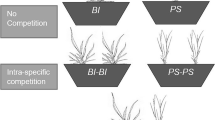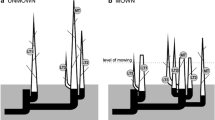Abstract
Recruitment of rhizomatous perennial grass ramets primarily occurs from the belowground bud bank. Investment in guerilla versus phalanx growth is determined by bud availability, development, and spatial distribution. The tiller and bud bank dynamics of Pascopyrum smithii, a dominant rhizomatous grass of the northern mixed-grass prairie, were examined in South Dakota throughout an annual cycle to assess the investment in guerilla versus phalanx growth and the role of different bud populations in renewal versus regenerative functions and vegetative spread via rhizomes. Pascopyrum smithii invested substantially in both phalanx and guerilla tiller production. However, investment in rhizome production before tiller recruitment prioritized guerilla over phalanx growth. Annual tiller recruitment of P. smithii was capable of flexible timing, occurring in either spring or fall. Renewal buds, from which rhizomes and tillers were recruited, primarily consisted of the youngest generation of buds borne at the base of tillers. Although rhizome axillary buds and older tiller axillary buds were rarely used in annual tiller recruitment, they provided a sizable reserve (regenerative) bud bank. The spatial distribution of bud development produced the mixed guerrilla–phalanx growth pattern and flexible tiller recruitment timing of P. smithii. Therefore, P. smithii is capable of employing both conservative and foraging growth strategies which will facilitate its persistence under local neighborhood variability and changing resource availability associated with environmental change. Understanding the spatial distribution of buds as determined by rhizome architecture is essential to understanding the distribution and composition of species within plant communities dominated by clonal species.



Similar content being viewed by others
References
Agresti A (2007) An introduction to categorical data analysis. Wiley, Hoboken
Asay KH, Jensen KB (1996) Wheatgrasses. In: Moser LE, Buxton DR, Casler MD (eds) Cool-season forage grasses. American Society of Agronomy, Madison
Briske DD, Derner JD (1998) Clonal biology of caespitose grasses. In: Cheplick GP (ed) Population biology of grasses. Cambridge University Press, New York
Busso CA, Mueller RJ, Richards JH (1989) Effects of drought and defoliation on bud viability in 2 caespitose grasses. Ann Bot 63:477–485
Carlsson BA, Callaghan TV (1990) Programmed tiller differentiation, intraclonal density regulation and nutrient dynamics in Carex bigelowii. Oikos 58:219–230
Chen XS, Xie YH, Deng ZM, Li F, Hou ZY (2011) A change from phalanx to guerrilla growth form is an effective strategy to acclimate to sedimentation in a wetland sedge species Carex brevicuspis (Cyperaceae). Flora 206:347–350
Dalgleish HJ, Kula AR, Hartnett DC, Sandercock BK (2008) Responses of two bunchgrasses to nitrogen addition in tallgrass prairie: the role of bud bank demography. Am J Bot 95:672–680
de Kroon H, Knops J (1990) Habitat exploration through morphological plasticity in 2 chalk grassland perennials. Oikos 59:39–49
de Kroon H, Schieving F (1990) Resource partitioning in relation to clonal growth strategy. In: van Groenendael J, de Kroon H (eds) Clonal growth in plants: regulation and function. SPB Academic Publishing, The Hague
Frank AB, Karn JF (1988) Growth, water-use efficiency, and digestibility of crested, intermediate, and western wheatgrass. Agron J 80:677–680
Geber MA (1990) The cost of meristem limitation in Polygonum arenastrum: negative genetic correlations between fecundity and growth. Evolution 44:799–819
Gibson J (2009) Grasses and grassland ecology. Oxford University Press, New York
Great Plains Flora Association (1986) Flora of the great plains. University Press of Kansas, Lawrence
Harper JL (1977) Population biology of plants. Academic Press, London
Hendrickson JR, Briske DD (1997) Axillary bud banks of two semiarid perennial grasses: occurrence, longevity, and contribution to population persistance. Oecologia 110:584–591
Humphrey LD, Pyke DA (1998) Demographic and growth responses of a guerrilla and a phalanx perennial grass in competitive mixtures. J Ecol 86:854–865
Judziewicz EJ, Clark LG, Londono X, Stern MJ (1999) American bamboos. Smithsonian Institution Press, Washington, DC
Klimesova J, Klimes L (2007) Bud banks and their role in vegetative regeneration—a literature review and proposal for simple classification and assessment. Perspect Plant Ecol Evol Syst 8:115–129
Klimesova J, Klimes L (2008) Clonal growth diversity and bud banks of plants in the Czech flora: an evaluation using the CLO-PLA3 database. Preslia 80:255–275
Lamp HF (1952) Reproductive activity in Bromus inermis in relation to phases of tiller development. Bot Gazette 113:413–438
Lovett Doust L (1981) Population dynamics and local specialization in a clonal perennial (Ranunculus repens). 1. The dynamics of ramets in contrasting habitats. J Ecol 69:743–755
McIntyre GI (1967) Environmental control of bud and rhizome development in seedlings of Agropyron repens L. Beauv. Can J Bot 45:1315–1326
McIntyre GI (1976) Apical dominance in rhizome of Agropyron repens—influence of water stress on bud activity. Can J Bot 54:2747–2754
Monson RK, Sackschewsky MR, Williams GJ III (1986) Field measurements of photosynthesis, water-use efficiency, and growth in Agropyron smithii (C3) and Bouteloua gracilis (C4) in the Colorado shortgrass steppe. Oecologia 68:400–409
Mueller RJ, Richards JH (1986) Morphological analysis of tillering in Agropyron spicatum and Agropyron desertorum. Ann Bot 58:911–921
Mullahey JJ, Waller SS, Moser LE (1991) Defoliation effects on yield and bud and tiller numbers of 2 Sandhills grasses. J Range Manag 44:241–245
Murphy JS, Briske DD (1992) Regulation of tillering by apical dominance—chronology, interpretative value, and current perspectives. J Range Manag 45:419–429
Navas ML, Garnier E (1990) Demography and growth forms of the clonal perennial Rubia peregrina in Mediterranean vineyard and unmanaged habitats. J Ecol 78:691–712
Ott JP (2014) Ecological implications of grass bud bank and tiller dynamics in mixed-grass prairie. Dissertation, Kansas State University
Ott JP, Hartnett DC (2012a) Contrasting bud bank dynamics of two co-occurring grasses in tallgrass prairie: implications for grassland dynamics. Plant Ecol 213:1437–1448
Ott JP, Hartnett DC (2012b) Higher-order bud production increases tillering capacity in the perennial caespitose grass Scribner’s Panicum (Dichanthelium oligosanthes). Botany 90:884–890
Rogler GA (1962) The wheatgrasses. In: Hughes HD, Heath ME, Metcalfe DS (eds) Forages: the science of grassland agriculture. Iowa State University Press, Ames
Rusch GM, Wilmann B, Klimesova J, Evju M (2011) Do clonal and bud bank traits vary in correspondence with soil properties and resource acquisition strategies? Patterns in Alpine communities in the Scandian Mountains. Folia Geobot 46:237–254
SAS Institute (2008) SAS 9.2. SAS Institute, Cary
Soil survey staff, Natural Resources Conservation Service, United States Department of Agriculture (2013) Web soil survey. http://www.websoilsurvey.nrcs.usda.gov/. Accessed 1 May 2014
Turkington R, Hamilton RS, Gliddon C (1991) Within-population variation in localized and integrated responses of Trifolium repens to biotically patchy environments. Oecologia 86:183–192
Watson MA (1984) Developmental constraints—effect on population growth and patterns of resource allocation in a clonal plant. Am Nat 123:411–426
Watson MA, Hay MJM, Newton PCD (1997) Developmental phenology and the timing of determination of shoot bud fates: ways in which the developmental program modulates fitness in clonal plants. In: de Kroon H, van Groenendael J (eds) The ecology and evolution of clonal plants. Backhuys Publishers, Leiden
Weaver JE (1968) Prairie plants and their environment: a fifty-five year study in the midwest. University of NE Press, Lincoln
White RS, Currie PO (1983) Prescribed burning in the Northern Great Plains—yield and cover responses of 2 forage species in mixed grass prairie. J Range Manag 36:179–183
White R, Murray S, Rohweder M (2000) Pilot analysis of global ecosystems: grassland ecosystems technical report. World Resources Institute, Washington, DC
Ye XH, Yu FH, Dong M (2006) A trade-off between guerrilla and phalanx growth forms in Leymus secalinus under different nutrient supplies. Ann Bot 98:187–191
Zhang J, Romo JT (1995) Impacts of defoliation on tiller production and survival in Northern wheatgrass. J Range Manag 48:115–120
Zhang JT, Mu CS, Wang DL, Wang JF, Chen GX (2009) Shoot population recruitment from a bud bank over two seasons of undisturbed growth of Leymus chinensis. Botany 87:1242–1249
Acknowledgments
This work was supported by the Kansas State University Division of Biology, the Konza Prairie Long-Term Ecological Research Program, and the USDA Rangeland Research Program [Grant number 310306]. We thank C. Ferguson, J. Nippert, and L. Murray for helpful suggestions on previous drafts of this manuscript. We also thank K. Sebes for lab assistance, and Wind Cave NP, especially B. Burkhart, for their field site support.
Author information
Authors and Affiliations
Corresponding author
Additional information
Communicated by Lori Biederman.
Electronic supplementary material
Below is the link to the electronic supplementary material.
Rights and permissions
About this article
Cite this article
Ott, J.P., Hartnett, D.C. Bud bank dynamics and clonal growth strategy in the rhizomatous grass, Pascopyrum smithii . Plant Ecol 216, 395–405 (2015). https://doi.org/10.1007/s11258-014-0444-6
Received:
Accepted:
Published:
Issue Date:
DOI: https://doi.org/10.1007/s11258-014-0444-6




